|
The names of most of the composers whose instrumental
works were performed either in St. Mary’s Chapel or St. Cecilia’s
Hall, either by the orchestra or by soloists, may be comprised in
the following list: —
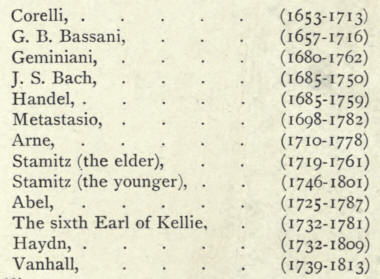

A very rich list, for it includes representatives of
the older music, as also names yet heard in all series of classical
concerts.
Of these composers, all except Corelli, Geminiani,
Bach, Handel, and the elder Stamitz were alive when St. Cecilia’s
Hall was built.
The following are the names of composers
whose vocal work? were given by the Musical Society :—
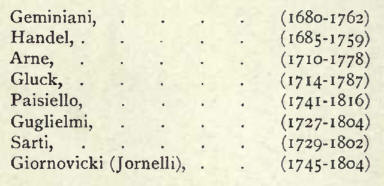
Of these musicians all save the first two were living
at the time the hall was built.
We are fortunate in being able to give a reduced
facsimile page from a manuscript index of the music belonging to the
Edinburgh Musical Society in 1782. The index, which is in the
possession of Mr. Robert A. Marr, is in its original binding with
rough calf back and corners, and consists of 128 pages post folio
size. On the front board is a paper label, neatly printed by
hand,and inside the board the contents are given as follows:—
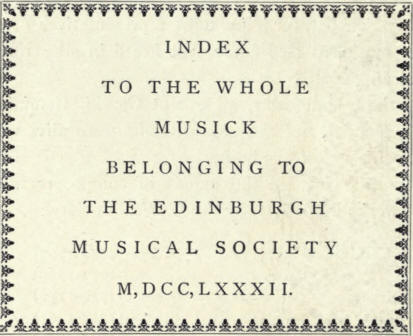
CONTENTS
1. Index of the whole music in alphabetical order.
2. Index of all the overtures.
3. Contents of all the music in score.
N.B. The Quintetti and Quartetti in the letter Q:
first Index. The Harpsichord
Music : the leaf before the last Index.
The page reproduced is the index of all the overtures
under the letter A, and a glance will show how representative a
collection the Musical Society possessed. The index has been most
carefully compiled, and pencil jottings indicate that it has been in
use until 1802. This was two years after the Society was dissolved,
so that apparently one of its late members was in possession both of
the pieces of music and of their index.
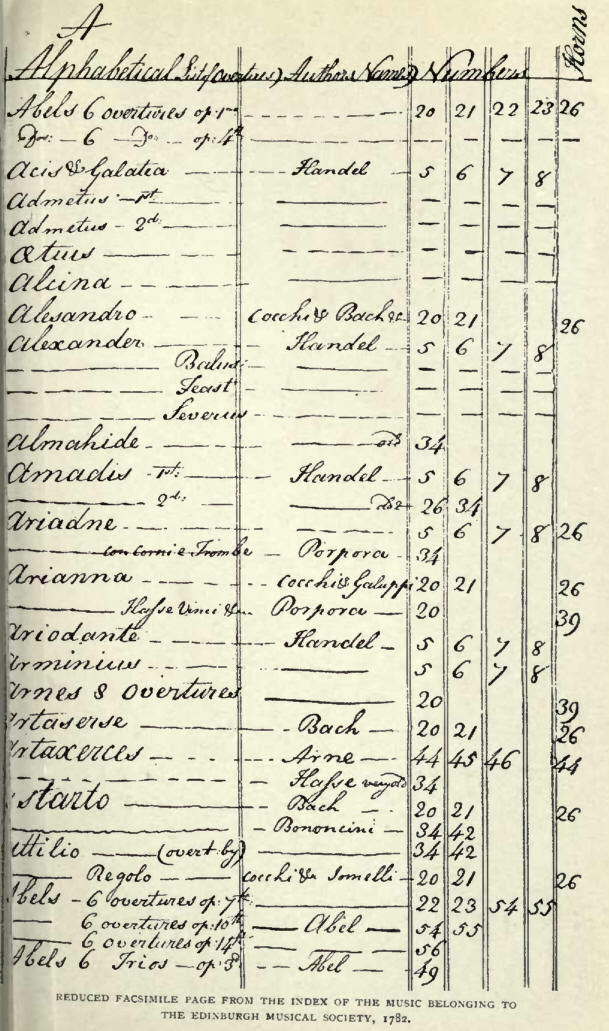
Certain of the composers’ names before mentioned are
household words, concerning which every one pretending to the ‘ pitifulest
fraction ’ of culture knows something. Other names, however, we feel
certain, call up few attendant facts in the minds of any persons who
are not professedly musical specialists, and therefore a note or two
upon some of these less-known musicians may be acceptable.
Archangelo Corei.i.i was born in 1653 in the Italian
city of Fusignano near Imola, and died on January i8th. 1713, in
Rome, being buried beneath a monument in tlie Church of Santa Maria
della Rotunda in that city.
Having studied music under Matteo, Simonelli, and
Bassani, he travelled in Germany, but soon settled in Rome, where
the greater part of his life \vas spent teaching music, like almost
all his brethren of the fiddle-stick. One of his pupils—the
greatest—was Geminiani. In Rome, Handel met Corelli and quarrelled
with him, a thing quite in Handel’s usual manner: the great German,
like most geniuses, preferred his own way.
Corelli published his first series of sonatas in
1683, a second in 1685, a third in 1690, a fourth in 1694, and a
collection of concertos, his last work, in 1712. He also left a
number of gavottes.
Musical experts have a considerable meed of praise to
offer to Corelli : he is described as a great violinist who laid
down principles for the development of a much more elaborate
technique, albeit in a purer style, than had previously been
considered possible by the most ambitious executants. Corelli, in
other words, created a new epoch in violin-playing by evolving
potentialities in that instrument hitherto totally unsuspected, so
that he is justly regarded as the founder of modern violin-playing
and violin-composition.
Corelli is further reckoned as one of the greatest
composers for the solo violin, notwithstanding that his chamber
sonatas and his concerti grossi are by musical critics considered of
high merit.
Musicians describe his style as possessing a ‘ quiet
elegance,’ pathetic in slow time, but confessedly dry in quick.
During the whole of last century this composer was greatly in
vogue—a popularity due in large measure to the zeal of his pupil and
editor, Geminiani.
Giovanni Battista Bassani was born at Padua in 1657,
and died at Ferrara in 1716.
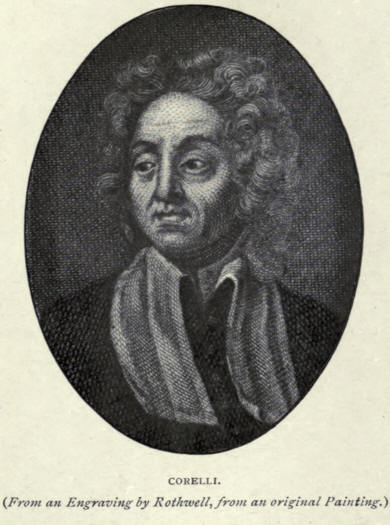
Thomson says it was his motctti that were played in
the St Mary’s Chapel concerts.
He wrote much more than motets—cantatas and operas,
besides a great deal for solo voice.
He was maestro da capella at Bologna Cathedral and
subsequently at Ferrara. In 1682 he was appointed Director of the
Academia dei Filarmonici at Bologna.
Bassani's music is described as religious in tone, ‘
writh extreme delicacy in the management of pathetic effects.’
Francesco Geminiani was born at Lucca in 1680, and
died at Dublin in 1761. Geminiani had drunk to the full of the
spirit of his famous master ; but, though entirely ‘of the school of
Corelli,’ he added to the characteristics of the Corellian manner of
execution an unbounded vivacity of temperament. Tartini called him
‘il furibundo Geminiani.’ He was himself a very skilful violinist,
and on coming to England in 1714 showed British musicians for the
first time how Corelli ought really to be played, for, previously to
this, that composer had been considered ‘ insurmountably difficult.’
Geminiani at the outset emphasised the rules Corelli
had laid down for the actual handling of the violin, and he
recommended holding the instrument on the left of the tail piece.
After having been for some little time in England, he was brought
under the notice of Lord Essex, through whose influence he was
appointed to the conductorship of the vice-regai band in Dublin
Castle. He was not allowed to take up this post—probably because he
was a Roman Catholic —and his pupil Dubourg got it instead.
Geminiani had the honesty and gratitude to speak of Great Britain as
his ‘second Fatherland.’
Like so many of his order, Geminiani was most
improvident. His hobby was buying pictures, and this would have
brought him to the very verge of poverty had not Sir Robert Walpole
come to his aid. Cecilia Young (Mrs. Thomas A. Arne) was a pupil of
Geminiani.
His compositions include sonatas for violin, solos,
and concertos; while his published works are:-—// Dizionario, Rules
for Play ing in a true Taste, and the Art of Playing on the
Violin, the Art of Playing on the Guitar, and the Art of
Accompaniment, which was translated into Italian, German, French,
and Dutch.
Along with Geminiani in 1714, there came to England a
performer on the tenor violin, Francesco Barsanti, who penetrated as
far north as Edinburgh, where in 1742 he published ‘A Collection of
Old Scots Tunes, with the bass for Violoncello or Harpsichord, set
and most humbly dedicated to the Right Honourable the Lady Erskine
by Francis Barsanti, Edinburgh.
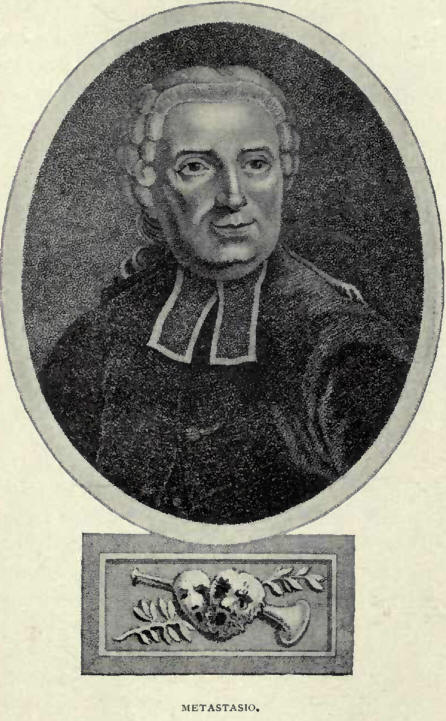
Printed by Alexander Baillie, and sold by Messrs.
Hamilton and Kincaid. Price 2s. 6d. Folio.’ Bar-santi, also a native
of Lucca, was born about 1690. By 1750 he had returned to London, so
that he played not in St. Cecilia’s Hall, but in St. Mary’s Chapel.
The next composer we shall notice whose works were
heard in the old hall is Pietro Antonio Domenico Bonaventura
Metastasio, who was born in Rome in 1698, and died at Vienna 1782.
It is as a dramatic poet and not as a composer that his name is most
widely known; nevertheless, his genius had considerable range, for
he sang, played on the harpsichord, and composed musical pieces.
Born poor, he was educated by Vincenzo Gravina, the distinguished
writer on Italian law. While still a lad, having written some poetry
which attracted notice, he associated himself with the actress
Madame Bulgarim, and devoted his attention to melodrama.
His dramas Didone at Naples, Sirce at Venice, Catone,
Semiramide, and Artaserse at Rome (1730), were enthusiastically
received. In 1J29 the Emperor Charles vi. called him to Vienna,
bestowed upon him the title of 1 Caesarean Poet,’ with a liberal
allowance. He thereafter settled at the imperial court, where, a
great favourite, he was much honoured by the Empress Maria Theresa.
Thomas Augustine Arne, who was born in King Street,
Co vent Garden, 1710, and died in London, 5th March 1778, was
intended by his father fur the profession of law. Young Arne,
however, secretly taught himself to play the violin, and, on his
father discovering this, was allowed to pursue the study of music,
and was placed under the best masters. Arne’s first production was
the opera Rosamond,, words by Joseph Addison, produced in Lincoln’s
Inn Fields Theatre in 1733, in which a younger brother and his
sister Susanna Maria took parts. This lady was afterwards wife of
Theophilus Cibber, son of Colley Cibber, the dramatist and
poet-laureate. It was by her brother Thomas’s advice that she
studied tragedy, in which her father-in-law, actor as well as
writer, gave her lessons.
Arne’s next production was the Opera of Operas, but
his music to Comus (1738) first showed his talent. Its success was
immediate, and its popularity long-sustained. In 1759 the University
of Oxford conferred upon him the degree of Doctor of Music. In 1762
Dr. Arne composed the opera of Artaxerxes—the first in the Italian
style by an Englishman for English people, and in this our old St.
Cecilia hero, Tenducci, sang. The very popular Love in a
Village followed Artaxerxes.
Dr. Arne is indissolubly associated with English
music. He practically initiated an era in operatic composition, and
his having written ‘incidental music’to five plays of Shakespeare
will ever retain his name in the best literary company.
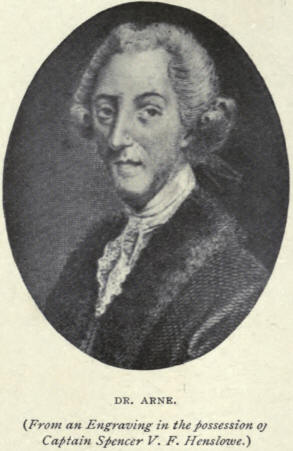
He wrote the music to the songs in As Ymt Like Li in
1740; to those in the Twelfth Night in 1741; 'n the Merchant of
Venice, 1742; in the Ttmpest,, 1746; in Romeo and Juliet, 1750.
Everybody knows Dr. Arne’s 1 Where the bee sucks, there lurk I,’
from the Tempest (Ariel’s song); also ‘ Blow, blow, thou Winter
Wind,’ and ‘It was a lover and his lass,’ from As You Like Lt, and
the clown’s ‘ Come away, come away, Death,’ from the Twelfth Night.
Still more widely known is the air, ‘Rule Britannia,’
which Arne composed for the song by James Thomson in a play, The
Masque of Alfred, the joint production of Thomson and Malloch
(Mallet), first performed August 14th, 1740, before Frederick,
Prince of Wales. Arne composed this music at the Prince’s residence,
Cliveden House.
Dr. Arne, it is said, rearranged an old air into that
of‘God Save the Queen’ (King); but there is, I find, no little
evidence to prove that the original words and music of the ‘National
Anthem ’ were by Anthony Young, Dr. Arne’s wife’s grandfather, who
was organist of St. Clement’s Dane and St. Catherine Cree near the
Tower, London.
Arne wrote two oratorios, The Death of
Abel and Judith, very little heard of nowadays. In 1740 he married
Cecilia Young, daughter of Charles Young, the organist of All
Hallows’, Barking, London. Young had been frequently employed by
Handel to play the organ parts in his oratorios. Cecilia was one of
the singers in Arne’s Comus.
After a visit to Ireland, Dr. and Mrs. Arne returned
to London in 1744, and entered into an engagement at Drury Lane, and
afterwards at Vauxhall, ‘as musical composers.’
During this time Arne wrote much—ballads, cantatas,
duets, and trios, publishing them in an annual collection
called Lyric Harmony. Dr. Arne lies buried in St. Paul’s Church,
Covent Garden.
There were two musicians of the name of Stamitz,
father and son.
Johann Stamitz was born in 1719 in Deutschbrod, a
small town in Bohemia, where his father was a schoolmaster. By 1756
he had established himself at Manheim as chamber-musician and
conductor of the concerts, and was recognised as the founder of the
violin school at Manheim, which a hundred and
Wermigey, Tottenhill, King’s Lynn, Norfolk. The claim
of Henry Carey to the authorship of this famous ‘ air ’ ha? lieen by
many accepted as settled, but the point cannot yet be said to be
decided. The earliest claimant is Dr. John Hull, organist to the
Chapel-Royal (1591).
fifty years ago enjoyed quite a high reputation. Its
fame attracted the Earl of Kelly as a young man from far Edinburgh,
and he studied music under Stamitz himself.
This ‘professor’ of music published symphonies,
overtures, concertos, quartets, and trios which are described by the
old Dictionary as having ‘ deservedly attained celebrity,’ but
‘though truly masterly,’ it continues, ‘they are still of the old
school, and are considered by some critics to savour too much of the
church style.’ It is Johann’s compositions that Thomson alludes to
as having been played in old St. Cecilia’s before the arrival of
Haydn's or the more modern music. This musician was considered quite
a successful orchestral composer. He died at Manheim in 1761.
Speaking of Frangois Cramer, the oldBiographical Dictionary says,
‘He made himself well acquainted with the . . . capriccios of Benda
and old Stamitz.’
Carl Stamitz, elder son of the preceding, was born at
Manheim in 1746, and studied the violin under his father.
In 1770 he went to Paris, and there for many years
sustained a reputation as an instrumental composer as well as
‘concerto player on the violoncello and tenor.’ Some of his works
were published at Paris, some at Berlin, some at Amsterdam.
There is little doubt it was this Stamitz the younger
who was in London about 1784, for in Parke’s Memoirs we are told
that in that year in London instrumental music had ‘arrived at a
high degree of perfection,’ chiefly through the talents of certain
solo piayers therein enumerated. The list closes with ‘Stamstz and
Shield on the tenor.’ This was one of Carl’s instruments, and,
mentioned in connection with so rare a name—though apparently
misspelt,—leaves us in no doubt that it is Stamitz the younger who
is alluded to. He died in South Germany, in Jena, while on a journey
to Russia in 1801. His compositions are described as having fire and
spirit, and as being more in keeping with modern feeling than those
of his father —a very natural thing.
Karl Friedrich Abei,, who was born at Kothen in
Anhalt in 1725, and who died in London about 1787, was another of
the foreign composers of lesser note whose pieces this old hall has
heard. He was a famous player on the viol-da-gamba, and in the
tnreequarter-length portrait of h.m by Gainsborough is represented
playing upon this instrument. In conjunction with Johann Christian
Bach he. gave a series of successful concerts in London (1762-1782),
in which Bach played the harpsichord and Abel the viol-da-gamba. His
first public performance was in Dresden, whence in 1761 he came over
to England, where the Duke of York procured him the post of ‘
Director of the Queen’s Band.’ Grove states he was
appointed f chamber-musician to Queen Charlotte ’ (wife of George
hi.) in 1765. J. 13. Cramer vvas a pupil of Abel.
Abel had, it would appear, an enormously exaggerated
opinion of his own talents, for on one occasion, having been
challenged to perform something, he replied: ‘ Vat, shallenge Abel !
dere ish but one Gott and one Abel'
Johann Baptist Vanhall (Wanbal) was born at Nechanicz
in Bohemia in 1739, and died at Vienna in 1813. Though he is said to
have been of Dutch extraction, most of his life was spent in Vienna,
where he composed a goodly number of works, which in England enjoyed
considerable popularity immediately preceding the introduction of
Haydn’s music. It was in England indeed that much of Vannall’s work
was published— symphonies, quartets, trios, duets, solos, and sets
of sonatas for the harpsichord. Although his name is hardly ever
mentioned nowadays, Vanhall was considered bycontemporaries to have
combined pleasing harmony and considerable melody in a ‘free, manly
style,’ for he was a violinist as well as a composer. The
old Biographical Dictionary speaks of the 1 spirited, natural, and
unaffected symphonies of this excellent composer.’ He is accredited
with quite a number of operas—nine or more—and a hundred symphonies,
besides quartets and masses.
Ignace or Ignaz Joseph Pleyel, born 1757, died 1831,
was another composer whose music was heard at St. Cecilia’s. At an
early age he evinced musical ability, and studied music in Vienna
under Vanhall and Haydn. After residence in Italy, he was
made Kapellmeister*at Strassburg, where he wrote a large number of
compositions for the harpsichord. In 1791 he came to London to
conduct the ‘ Professional Concerts ’ of the season, and on the
first occasion did so in the presence of Haydn, upon 13th February
1792.
Mozart thought so much of Pleyel, that he declared he
would do ‘to succeed Haydn,' and certainly he copied that master so
closely as to preclude originality. Considering himself ill-treated
in Strassburg, he removed to Paris, where jhe founded the firm of
pianoforte makers, ‘Pleyel and Co.’ His eldest son was Camille (born
1788, died 1855); and Camille’s wife (born 1811) became a great
pianist, and died only in 1875. .
Pleyel, as we have said, wrote a number of airs for
the Thomson collection of Scottish songs, and in this connection is
twice mentioned in letters of Burns. In letter viii. (April 1795)
Burns writes:—‘One hint let me give you—whatever Mr. Peyel1 does,
let him not alter one iota of the original Scottisn airs.’ Again, in
letter xvi. (May 1794) he writes:—‘I am quite vexed at Pleyel’s
being cooped up in France, as it will put an entire stop to our
work.’ A writer in 1793 speaks of ‘the popular writers on the
Continent, Haydn, Pleyel,’ etc.
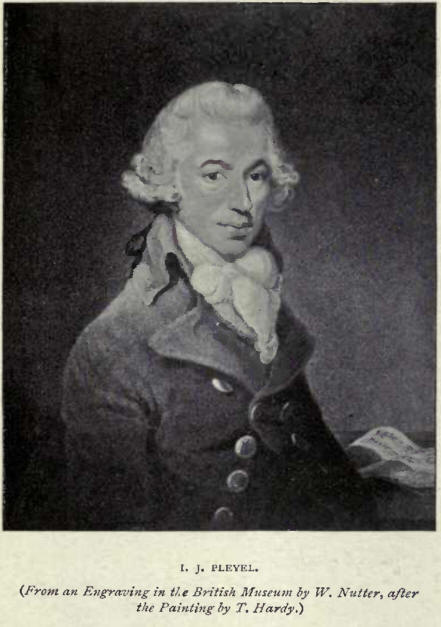
Pietro Guglielmi, son of Joachim Guglielmi (musician
to the Duke of Modena), was born at Massa di Carrara in 1727, and
died at Rome in 1804. Having studied music with his father until he
was eighteen, he was sent to the famous conservatoire of Loretto at
Naples, the same which trained his contemporaries, Cimarosa and
Paisiello. Here he was drilled in counterpoint and composition, but
not until ten years later did he evince any power for original
musical work. On quitting the conservatoire, however, he began at
once to compose for the principal theatres of Italy. His operas,
both serious and comic, were equally successful, and most of them
were produced during the period of his rivalry with Paisiello, who
seemed to regard the patronage of the theatre of Naples as his own
special monopoly. No sooner did Pasiello compose an opera, than
Guglie Guglielmi’s fame spread considerably, for he was invited to
Vienna, to Madrid, and to London, returning to Naples from a
prolonged tour when in his fiftieth year. In the opinion of many,
some of his operatic works were finer than the corresponding ones of
Paisiello.
In 1793, Pope Pius vi. offered him the post
of maestro di capella at St. Peter’s, which he accepted. This gave
him the opportunity of composing more especially for the church, and
in the comparative leisure of this congenial post he spent the last
eleven years of his life.
Guglielnr's collected works exceed two hundred. Two
oratorios of his should be mentioned, Tht Death, of Holofernes and Deborah,
the latter being regarded by some as his chef-d'ttuvrt. Parke the
oboist tells us that in 1813 ‘the King’s Theatre opened on the 6th
of January with Guglie’mi’s serious opera Sidagero.’ Experts
describe Guglielmi’s music as having a clear and supported harmony,
simple and elegant melodies, while originality characterises not a
few pieces.
Giovanni Paisiello, one of the most famous musicians
of the Neapolitan school, was born at Tarento in 1741, and died at
Naples in 1816. Heredity cannot account for his great gifts in
composition, for he was the son of a veterinary surgeon in the
service of Charles in. of Naples. His father sent him to the Jesuit
College at Tarento, where it was discovered that he had a fine
contralto voice. In June 1754 he wao placed under
Durante in the conservatorio of St. Onofrio; before
1763 he had composed masses, psalms, oratorios, motets, and ‘a comic
interlude,’ and in that year he composed his first opera, a piece
for the theatre at Bologna. Then for the theatres at Venice, Naples,
Rome, Milan, Bologna, Modena, Parma, an immense number of operas
were all written by the middle of 1776.
In July of that year he accepted service as musician
in the court of Catherine h. at St. Petersburg, with an income from
one source and another of nine thousand roubles.
Amongst the operas of the pre-Russian epoch may be
mentioned La Pupilla, II Marchese Tulpiano, and La Semiramide. Paisiello
had actually been engaged to compose for the King’s Theatre, London,
but his invitation to the Russian imperial court caused him to
forego the English engagement. During his stay in Russia, Paisiello
composed several operas and a good deal of music for the
harpsichord. II Barbiere di Sivig/ia, an opera, and La Passione, an
oratorio to Metastasio’s words, both belong to this period.
After a sojourn in Vienna, where he wrote an opera
for the Emperor Joseph n., he returned to Naples, and was
immediately taken into the service of King Ferdinand iv. as maestro
di capella. Hardly had this post been secured when an invitation
arrived from
King William of Prussia begging him to come to
Berlin. This he had to refuse, as also an invitation to go to Russia
for the second time.
He remained in Naples until 1789, when King Ferdinand
was deposed and a republican form of government established, the
members of which requested Paisiello to regard himself as ‘ composer
to the nation.’ To this he agreed; but on the restoration of the
Bourbons he found himself punished for what was considered
disloyalty, and in consequence deprived of his appointments.
Napoleon, as First Consul, invited him to Paris,
where we next find him composing a ‘ Te Deum ’ and a ‘Grand Mass’
for two choirs. He continued to live in Paris until after Bonaparte
was declared Emperor, for whose coronation ceremony he composed some
music.
Joseph Napoleon, as King of Naples, confirmed to him
his appointments of maestro di capella, composer of the music of the
chamber, at a salary of 1800 ducats. Napoleon sent him the Legion of
Honour, and honours poured upon him from home and foreign musical
societies. On 30th December 1809 he was elected Associate of the
Institute of France.
To rightly estimate Paisielio’s place amid the galaxy
of Italian composers is, at the present time, somewhat difficult,
especially as so little of his music is nowadays heard. No musician
was during his lifetime so universally admired or sought after.
Kings and princes clamoured for his services; but success, that ‘
touchstone of the human character,’.' never spoiled him.
The music of Paisiello is simple without being
insipid, clear and intelligent without lacking ornament and richness
of melody, sprightly and bright without being trivial.
He was the first to introduce the viola into comic
opera at Naples, and the first to bring concerted bassoons and
clarinets into use in both the theatre and churches of Naples.
Paisiello can be majestic, tragic, pathetic, comic,
without being heavy, terrific, insipid, or grotesque.
With the name of Giuseppe Sarti we may conclude the
list of the less-known composers whose songs were sung in
old St. Cecilia’s. He was born at Faenza in Italy in 1729, and died
in Berlin in 1802. In 1756 we find him court-musician at Copenhagen,
later at Venice, still later (1779) maestro di capella of the Duorno,
Milan. At this time his fame was already at its zenith : the Italian
theatres clamoured for his operas, his countrymen had named him ‘il
divino maestro,’ and his Giulio Sabino was shortly to procure him an
invitation to the Russian imperial court. This he accepted in 1785.
He at once fell in with the prevailing Russian taste for very noisy
music, and is said to have actually introduced into the performance
of a ‘ Te Deum,’ in presence of the court, the firing of cannon
placed outside the castle. In 1786 the Empress ennobled Sarti and
provided for him a most handsome income. He remained eighteen years
in St. Petersburg, only quitting it in 1801 by permission of
Alexander I. on account of ill health. He was making for the sunnier
south when death overtook him in Berlin. Sarti wrote two score or so
of opera buffa, but amongst his serious operas may be mentioned Didone (1767)
and La Cle-menza di Tito (17 71). Sarti visited London in 1769. |

